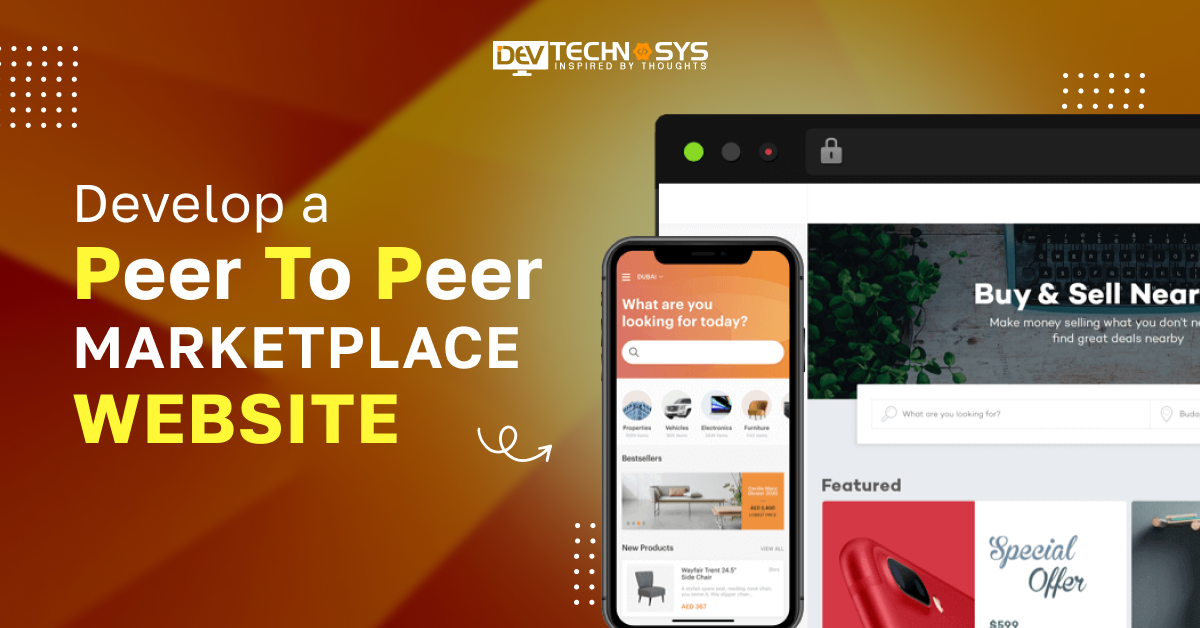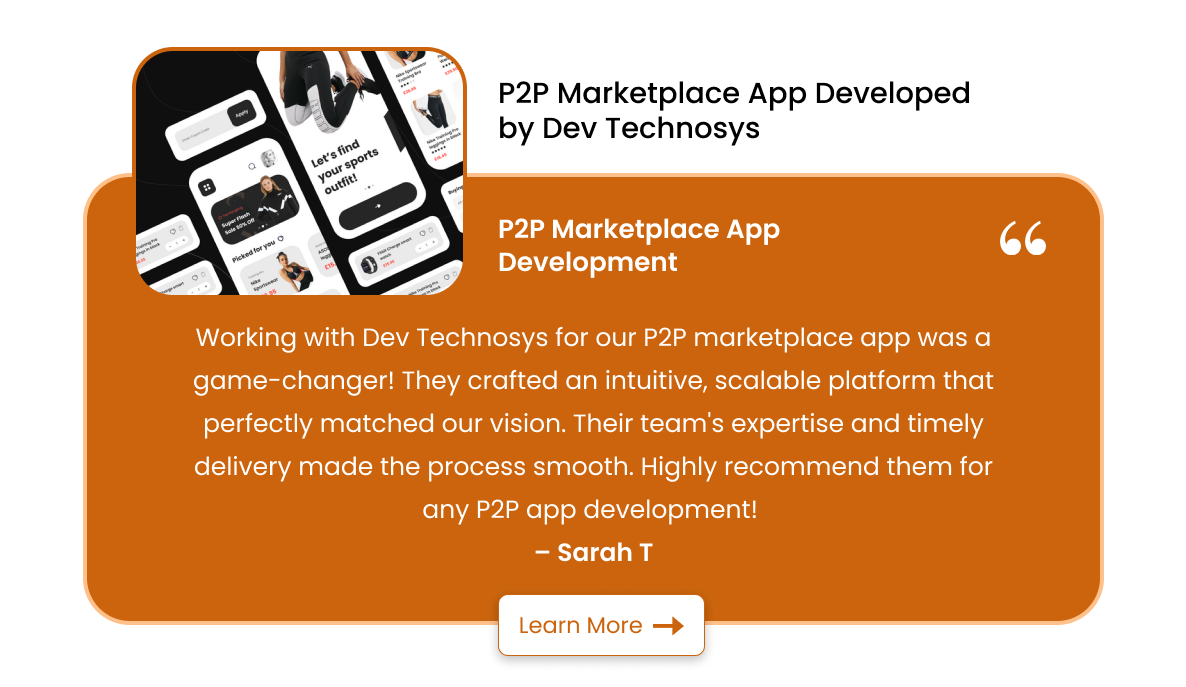Nowadays, there is a lot of demand for the online marketplace, or they are for it because they organize direct meetings of sellers or buyers. There are no intermediaries in between, so sellers can negotiate with buyers on their own terms. The peer-to-peer marketplace provides a wider range of services, such as selling or buying goods, financial assets, rental homes, e-commerce markets, and more.
According to global news, the peer-to-peer marketplace websites were valued at around $1,562.2 million in 2024. This is projected to grow with a rapid speed around $8,474 million by the end of 2034.
This upper data shows why businesses invest in peer-to-peer marketplace websites, and most e-commerce businesses convert their business into a p2p marketplace.
In this blog, we will provide an interesting journey on how to develop a peer-to-peer marketplace website and various fields of the marketplace.
What Is Peer to Peer Marketplace Website?
A peer-to-peer marketplace is an online platform that connects buyers to sellers directly to purchase goods and other items. Suppose users want to buy a used car, then the marketplace platform directly connects with the car’s owner, and this can reduce the intermediaries or middlemen. The marketplace platform offers a wide range of services, such as car rental, e-commerce, home rental, freelancer works, and more.
- No middlemen or intermediaries
- Wide Variety of Products/Services
- Global Reach
- Flexible Payment Options
Market Analysis of Peer-to-Peer Marketplace
- The peer-to-peer marketplace websites were valued at around $1,562.2 million in 2024. This is projected to grow rapidly to around $8,474 million by the end of 2034.
- As per the recent study, the peer-to-peer marketplace websites grow with a compound annual growth rate of 15.5% during the forecast period from 2025 to 2034.
- According to the global market, North America holds the highest share of the peer-to-peer marketplace at around 63% in 2024.
- With deep knowledge, the user penetration of the peer-to-peer marketplace is expected to increase by the end of 2028.
- The peer-to-peer marketplace offers a wide range of services, such as rentals, freelance, payments, and more.
Top 10 Best Peer-to-Peer Marketplace Websites
Are you searching for the best peer-to-peer marketplace website? Then you can stop here. We provide the popular p2p marketplace solutions that already hold higher successful rates and make their fixed position in this competitive market. So, here we provide the best p2p marketplace websites:
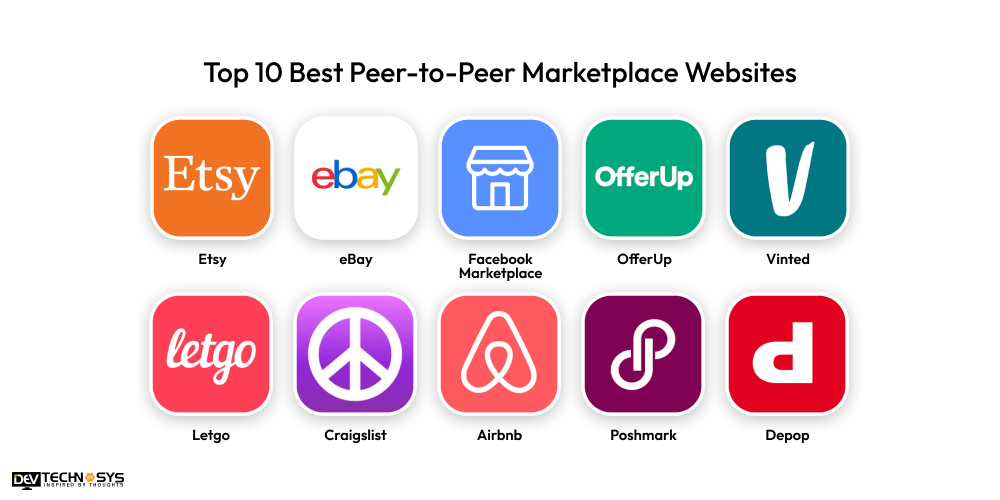
Apps |
Downloads |
Ratings |
Launched Year |
Platform Compatibility |
| Etsy | 50M+ | 4.5 | 2005 | Android, iOS, Web |
| eBay | 100M+ | 4.6 | 1995 | Android, iOS, Web |
| Facebook Marketplace | 100M+ | 4.1 | 2016 | Android, iOS, Web |
| OfferUp | 100M+ | 4.7 | 2011 | Android, iOS, Web |
| Vinted | 10M+ | 4.5 | 2008 | Android, iOS, Web |
| Letgo | 50M+ | 4.7 | 2015 | Android, iOS, Web |
| Craigslist | 10M+ | 4.0 | 1995 | Android, iOS, Web |
| Airbnb | 100M+ | 4.8 | 2008 | Android, iOS, Web |
| Poshmark | 50M+ | 4.6 | 2011 | Android, iOS, Web |
| Depop | 50M+ | 4.6 | 2011 | Android, iOS, Web |
Robust Types of P2P Marketplace Platforms
There are various types of peer-to-peer marketplace platforms that offer robust services, and every P2P marketplace software or platform has unique functionalities. Each marketplace is divided into various categories, such as P2P lending app development, financial, lending, e-commerce, and more. So, let’s take a look at the various peer to peer marketplace platform examples:
- Rental P2P Marketplace
- Services P2P Marketplace
- Crypto P2P Marketplace
- Lending P2P Marketplace
- E-commerce P2P Marketplace
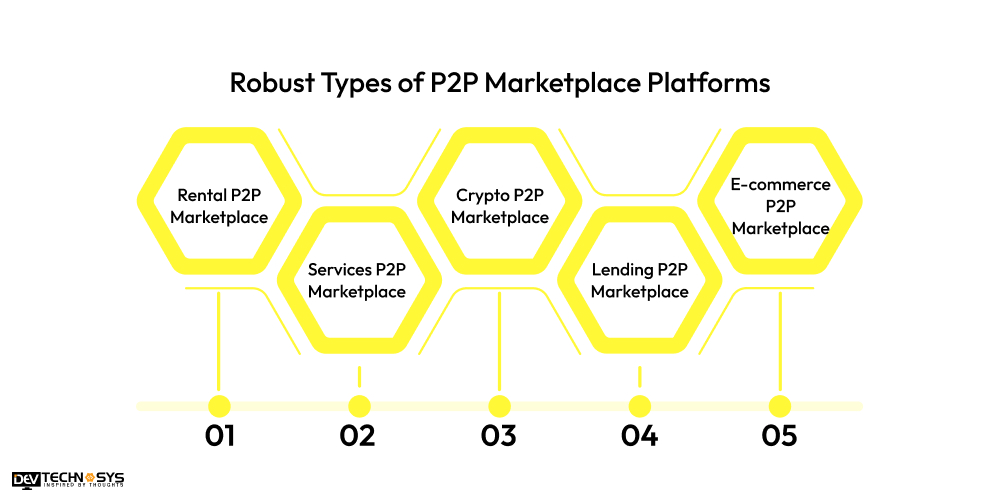
1. Rental P2P Marketplace
The rental p2p marketplace is one of the most used marketplaces for renting vehicles, homes, clothing, and other tools. It allows users to directly connect with the sellers or owners of the specific item. Airbnb is the most popular example of a peer to peer rental marketplace; it enables users to connect with real owners of property or homes.
- This marketplace offers various places that are available for rent.
- Users can search for a specific car and rent the car according to hours and days.
2. Services P2P Marketplace
The services p2p marketplace offers various services like home repairs, freelance work, home designing, event planning, and landscaping. This platform helps users to connect with the service provider directly and schedule their time for services. Upwork and TaskRabbit are the most common examples of providing robust services such as designing, programming, writing, consulting, delivery, and care services.
- It enables users to search for freelance work such as programming, web design, and graphic design.
- These services marketplace also offers services like home maintenance services and caring services.
3. Crypto P2P Marketplace
The P2P crypto exchange marketplace is one of the most used marketplaces for selling or buying cryptocurrencies from each other; there are no middlemen or intermediaries. It enables users to sell their cryptocurrencies across the world. Binance P2P is the most popular peer to peer crypto marketplace across the global audience. This can provide more security measurements to transfer the cryptocurrency from one to another.
- Cryptocurrency buyers and sellers can directly interact and agree on terms and conditions.
- This marketplace offers privacy and security techniques such as encryption and two-factor authentication.
4. Lending P2P Marketplace
This platform is for those who want to borrow money, so it connects them directly to those who want to lend money, and no bank or financial institution is involved in it. Various platforms work as a peer to peer lending marketplace, enabling users to receive instant money. It is also known as peer to peer payment app that matches the borrowers to lenders according to their specific demands.
- This platform follows an algorithm that matches the borrowers to perfect lenders.
- It offers 24/7 chat support features to solve the user’s queries and help them with any important concern.
5. E-commerce P2P Marketplace
E-commerce marketplaces are mainly for shopping, and they connect buyers directly with sellers without middlemen or intermediaries. They include various types of products such as clothing, accessories, electronics, appliances, and more. Apps like ETSY and eBay are the most popular examples of peer to peer shopping marketplaces that connect buyers to sellers for purchasing goods.
- It provides the detailed information about the buyers and sellers.
- This marketplace enables users to search for specific products and reach out to sellers for negotiable prices.
Why Entrepreneurs Are Ready To Invest In Peer-To-Peer Marketplace Website?
As we shown in the above sections, how rapidly the peer-to-peer marketplaces website is growing. These online marketplace websites are transforming the nature of selling and buying products or services, they directly connect with owners or suppliers to eliminate the commission. So, here we offer the robust benefits of peer to peer business platforms or websites:
- Highly Demanded
- Revenue Opportunities
- Reduce Operational Costs
- Competitive Advantage
- Data-Driven Insights
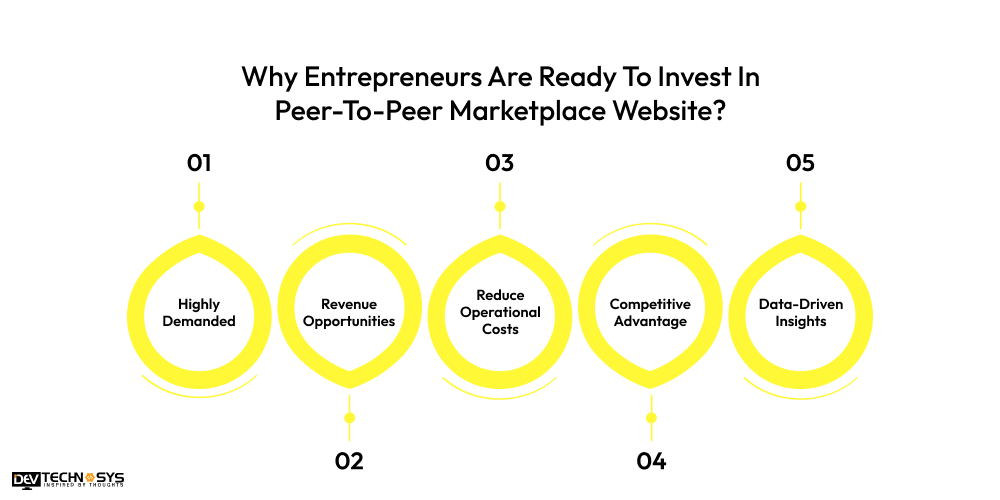
1. Highly Demanded
Let’s start with the first benefit: we show that these marketplace platforms are highly demanded in this competitive market. Its unique functionalities rule this market, and it includes order management, user profiles, secure payment options, and more. According to the ecommerce app development company, there are many entrepreneurs who want to transform their e-commerce business into an online marketplace.
2. Revenue Opportunities
This second benefit involves various revenue opportunities offered by online marketplaces. These include subscription plans, a freemium model, in-app purchases, transaction fees, delivery fees, collaborations, partnerships, and more.
This benefit is one of the most profit-generating opportunities for entrepreneurs and can increase overall valuations. So, it can also increase user engagement by offering robust specifications.
Interested in a chatbot demo, pricing, or more info? Fill out the form our expert will contact you shortly.
-
Chatbot Demo
-
Cost to Develop an app
-
Industry Report
-
Case Study
3. Reduce Operational Costs
Moving to the third benefit, If we talk about e-commerce, businesses need warehouses to manage their inventory, whereas online marketplaces do not have to do that much work; they simply connect buyers to sellers or act like a middleman. It can mainly reduce operational costs and help businesses to increase their productivity and reachability.
4. Competitive Advantage
Moving forward to the fourth benefit, a peer to peer business platform with unique or advanced features can gain a competitive advantage and reach global audiences. It includes rich features of the online marketplace, such as listing management, direct messaging, a secure payment gateway, community features, and searching.
According to the web portal development company, entrepreneurs want to invest in achieving global attention and make a specific position in this competitive market.
5. Data-Driven Insights
Let’s come to the last benefit: the online marketplace platform has the ability to observe the user’s daily activities, such as what they searched for and recently purchased items. It analyzes the user’s or customers’ habits, demographics, purchasing patterns, behavior, and preferences. With the help of these collective data, businesses can offer them personalized recommendations and identify areas for improvement.
7 Essential Steps To Develop a Peer-to-Peer Marketplace Website
Before starting the development process, you need to clarify the actual requirements of the project and what functionalities they installed. The below steps have the ability to clear all confusion and misunderstandings during the service marketplace development. It helps users to understand every step of development and easily implement the features and functions.
So, here we provide the online marketplace platform development process:
- Clear the Requirements and Goals
- Identify the Basic and Core Features
- Tech Stacks
- Design UI/UX
- Development of Website
- Testing and Quality Assurance
- Launching and Post-Maintenance
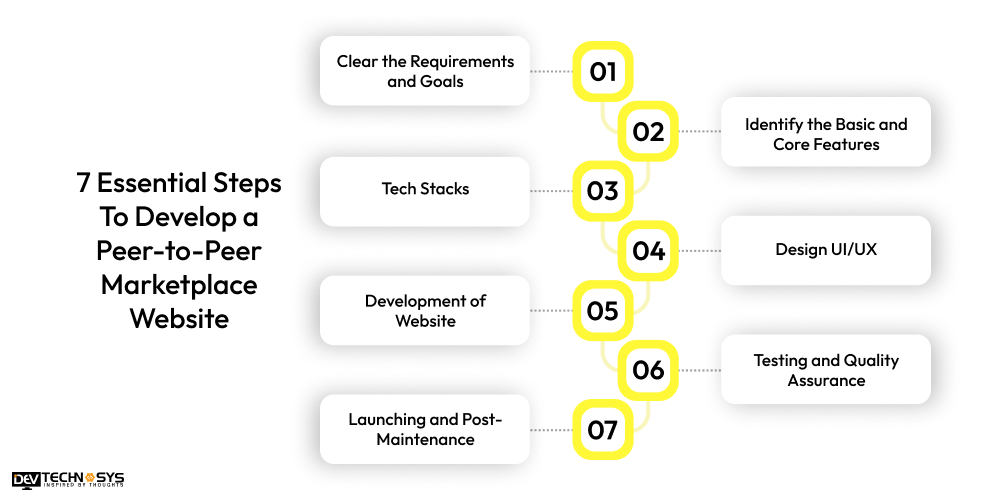
1. Clear the Requirements and Goals
Let’s start the first development stage; you need to clear the exact project requirements and needs. After that, set the future goals that in the upcoming years where you want to stand with your business. You can also observe the best online marketplace platforms and how rapidly they achieve higher success and understand their working process.
| What your website’s requirements and needs? |
| Define your future goals. |
| Which P2P marketplace solutions are more trending in this competitive market? |
2. Identify the Basic and Core Features
Coming to the second stage of service marketplace development, first, you need to make an organized sheet of features that can be installed in your marketplace platform. You can also look at the existing marketplace platform features and find the best features that help you achieve global success. Hire dedicated developers from an mobile app development company to identify your primary and secondary users of the marketplace platform.
| What are the key functionalities users expect from a marketplace peer to peer? |
| Does the platform offer messaging or communication tools between users? |
| Is this platform available for both, such as mobile or website? |
3. Tech Stacks
In the third marketplace website development stage, choose the best tech stacks that can easily handle the high number of user engagement. It includes various types of technologies such as HTML, CSS, and Javascript(For Front-end development), Python and Java(For Back-end development), MYSQL, and MongoDB(For Database). So, choose the right technologies that can easily fulfill your project’s requirements.
| Which type of programming languages used for the overall development? |
| Which database management system is used to store data? |
| What cloud services are used for hosting and scaling the application? |
4. Design UI/UX
Entering the fourth stage of peer to peer marketplace app development. Designing a website, is one of the most crucial stages, you have to choose the best designing tools to give an attractive look.
Hire mobile app developers from an Ecommerce development company to check the popular marketplace platform designs and implement these types of designs in your marketplace website. Use Adobe XD and Sketch to implement the premium templates and layouts.
| What tools or software were used to design the user interface? |
| How does the platform ensure ease of navigation for users? |
| Is your website design is responsiveness? |
5. Development of Website
Move to the fifth stage of ecommerce marketplace development, assemble a highly skilled development team to implement the various features and functions in the website. Developers have to integrate third-party APIs, advanced features, functions, and secure payment gateway integrations. In this development stage, the real coding begins to set the backend process for streamlining the technical operations.
| What frameworks or libraries are utilized in the website’s development? |
| How is user authentication and authorization implemented? |
| How are APIs integrated to extend the website’s functionality? |
6. Testing and Quality Assurance
Connect to the sixth stage of website development, after the completion of website development, hire web development company to test the website under robust testing techniques. Unit, security, integration, and functional testing are used to test the website and fix the bugs immediately. After the testing phase is done, check the website’s quality so that it is not decreased and passes the quality assurance.
| What types of testing are performed on the website (e.g., functional, usability, security)? |
| What processes are in place to handle bug tracking and resolution? |
| What is the process for testing third-party integrations or APIs? |
7. Launching and Post-Maintenance
Now, the time comes to end the development process. Hire experienced developers from ecommerce marketplace development company to launch the website successfully and ensure that all features and functions are successfully integrated. After the launch, it’s time to start the maintenance services.
You need to start the post-maintenance services and monitor the website’s overall performance and daily activities. Update the outdated features and services to the latest version and add some trending features.
| Observe the guidelines for successfully launching a website. |
| How are data backups handled during the launch process? |
| How are bugs and issues tracked after launch? |
10 Must Have Features of Peer-To-Peer Marketplaces
Are you ready to see the best features of a marketplace platform? You can observe these advanced features for implementation in your online marketplace website. So, here we provide the extraordinary or advanced features that help to businesses to reach a higher audience:
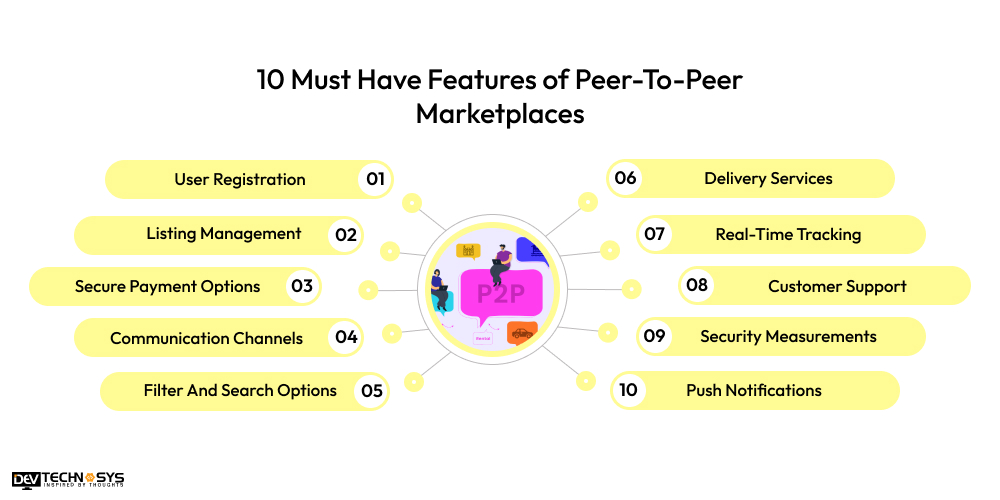
-
User Registration
The white label peer to peer marketplace allows users to create their account via personal information, social media platforms, official email address, and phone numbers.
-
Listing Management
Multi-vendor Ecommerce marketplace allows sellers to list their items or products for sale and describe the product information in detail with images, features, and others.
-
Secure Payment Options
The p2p web offers flexible payment options such as net banking, bank transfer, mobile wallet, credit or debit cards, and more online payment options.
-
Communication Channels
Online marketplace platforms offer various communication channels such as chat, call, and email to directly communicate with the sellers.
-
Filter And Search Options
This platform enables users to set the filter to find specific items or products and search for the individual services and items that are required by users.
-
Delivery Services
The site peer to peer marketplace offers robust delivery services such as instant delivery, same-day delivery, and standard delivery to deliver used products or items.
-
Real-Time Tracking
The marketplace like Amazon allows users to track their items in real time with the help of GPS integration. They also receive notifications about the order status.
-
Customer Support
The largest peer to peer marketplace solution provides customer support to handle the user’s queries and fix them as soon as possible.
-
Security Measurements
The site p2p offers various robust security measurements such as biometrics, two-factor authentication, encryption techniques, etc.
-
Push Notifications
The marketplace peer to peer sends users alert messages about their order status and messages about new updates.
How Much Does It Cost To Build A Peer To Peer Marketplace Website?
The cost to create a peer-to-peer marketplace website is around $8,000 to $25,000 or more based on the crucial factors. It includes various factors such as a high number of features, the project’s complexity, functions, size of the website, security implementation, third-party integrations, and more.
Businesses need to analyze their project’s requirements first and integrate the features according to their overall fixed budget. Here, we offer the cost table that provides the approximate cost:
Cost To develop a Peer to Peer Marketplace Website
Marketplace Website Development |
Estimated Cost |
Time Frame |
| Basic Website Development | $8000 – $13000 | 2 to 5 Months |
| Mid-Premium Website Development | $13000 – $20000 | 5 to 9 Months |
| High-Premium Website Development | $25000+ | 9+ Months |
5 Crucial Factors That Affect Peer to Peer Marketplace Website Development Costs
There are various factors that have the ability to affect the overall ecommerce marketplace development cost, and businesses need to avoid these types of factors. It includes the developer’s team, the project’s high complexity, a rich set of features, and more. So, let’s take a look at the following robust factors:
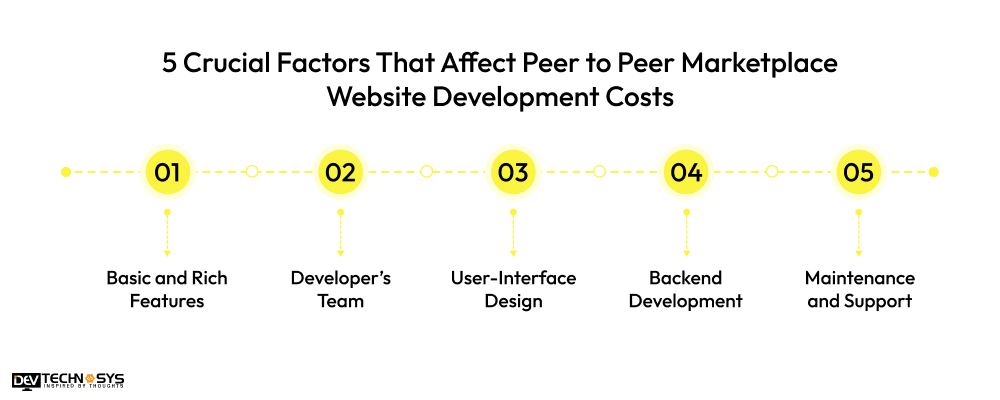
1. Basic and Rich Features
The features are divided into two halves basic and premium. Some are highly paid features, such as real-time tracking, direct communication channels, secure payment gateways, and push notifications, that can increase the p2p marketplace development cost. So, choose the features according to your fixed development budget.
Features |
Cost Estimation |
| Basic Features(Direct communication channels) | $8,000 – $14,000 |
| Premium Features(Push notification and listing management) | $15,000 – $20,000 |
2. Developer’s Team
Moving to the second factor, the development team is one of the most common factors that can easily affect the cost of website development. If your project’s complexity is high, then you have to hire experienced developers, but they demand higher salary packages. So, the shopping app development team can greatly affect the cost and change the development budget.
Development Team Location |
Cost Estimation |
| Asia Pacific Region | $7,000 – $14,000 |
| North America | $15,000 – $20,000 |
| Eastern Europe | $13,000 – $18,000 |
| Western Europe | $16,000 – $25,000 |
3. User-Interface Design
Let’s connect to the third factor: designing is a crucial factor that can change the cost of website development; it includes various premium paid designs. If you want to integrate complex design into your website, then it can lead the way to higher peer to peer marketplace website development costs. Premium design includes such as layouts, templates, built-in plugins, and more.
Design Quality |
Approximate Cost |
| Basic Design | $8,000 – $12,000 |
| Complex Design | $15,000 – $22,000 |
4. Backend Development
Let’s talk about the backend development cost factors; it includes various connectivity’s and processes such as database, API connectivity, and various third-party integrations. These resources have the ability to increase the online marketplace app development cost, and businesses have to choose limited integrations to reduce the cost.
Development of Backend |
Approximate Cost |
| Simple Backend Process | $10,000 – $18,000 |
| Advanced Backend Process | $20,000 – $25,000 |
5. Maintenance and Support
Moving to the last factor, maintenance and support can easily fluctuate the cost of website development. Ongoing maintenance services are crucial for websites to update the outdated features in their latest version. The maintenance and support services charge 15% to 20% of the overall website development cost.
Maintenance Process |
Cost Estimation |
| Basic Maintenance Process | $3,000 – $5,000/year |
| Complex Maintenance Process | $8,000 – $10,000/year |
How To Make Money From Peer-to-Peer Marketplace Website?
Well done, you successfully build an online marketplace website, but the main concern is how to make money from this marketplace website. Businesses have no idea how to generate new income sources. No need to worry about it. We provide the best monetization techniques that can generate new revenue streams:
- Subscription Plans
- Transaction Fees
- Advertisements
- Listing Fees
- Freemium Model
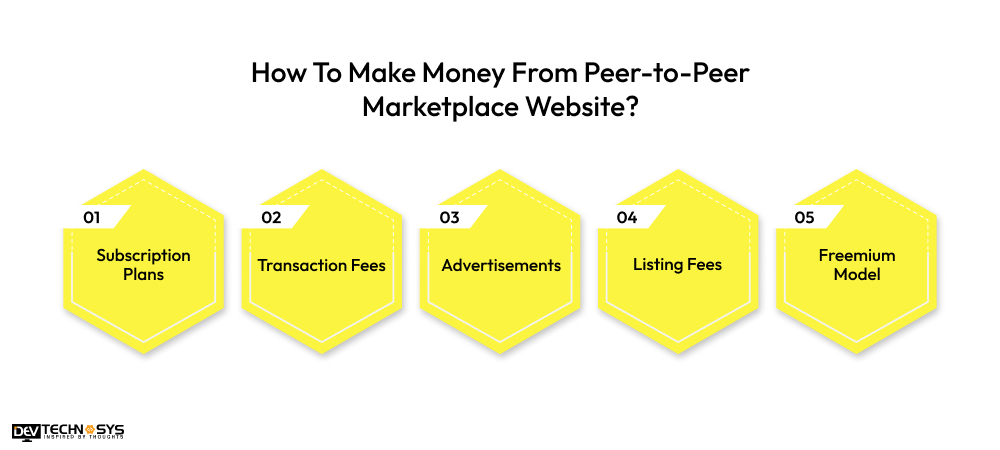
1. Subscription Plans
Let’s start with the first monetization technique. The best peer-to-peer marketplace offers paid subscription plans that allow users to access advanced features by purchasing a premium plan. There are various types of subscription plans, such as basic, premium, and enterprise. Users want to purchase paid plans to access paid services, so this can generate new revenue streams.
2. Transaction Fees
The second monetization technique, transaction fees, is one of the most common monetization techniques. Peer-to-peer marketplace platforms charge transaction fees on every payment transaction done by the user. According to the marketplace development company, It charges around 2% to 5% of each payment transaction, and it can generate new revenue streams.
3. Advertisements
Another monetization technique is peer-to-peer selling platforms, which allow third-party businesses to advertise their products and services in your app. These platforms involve many advertisement formats, such as native ads, banner ads, image ads, and more. You can charge a fee for showing their products and items.
4. Listing Fees
Connecting to the second monetization technique, p2p websites charge a fee from the seller to list their items on the platform. You can charge fees of around 3% to 6% for every product that is listed. So, with the help of listing fees, businesses can increase their overall valuation and generate new revenue streams.
5. Freemium Model
Entering the last money-making technique, open source peer to peer marketplace software with basic functionalities are available for free users. If they want to access premium services, they need to purchase additional features or subscription plans. As we discussed earlier with web development services provider, these can increase the user base and also create a new source of money-making.
Conclusion
Let’s finish this blog with final thoughts. We provide detailed information about how to develop a peer-to-peer market website and how today’s businesses can make a profit from this.
It includes high-tech features such as communication channels, instant delivery services, real-time order tracking, customer support, push notifications, and listing management. We also provide money-making strategies, and businesses can easily generate new revenue streams.
To develop a peer-to-peer marketplace website, freely reach out to our marketplace app development company to deliver cost-effective development solutions.
Frequently Asked Questions
Q1. How Much Does It Cost To Develop a Peer-to-Peer Marketplace Website?
The simple peer to peer marketplace website development cost around $8,000 to $14,000. A complex p2p website costs around $25,000 or more, depending on their specific requirements and development team.
Q2. How Much Time Does It Take To Build a Peer-to-Peer Marketplace Website?
To create a peer to peer marketplace website with custom functionalities takes around 4 to 9 months. The time depends on various factors such as the project’s complexity, the developer’s working hours, and more.
Q3. Why Do Businesses Invest In The Peer-to-Peer Marketplace Platform Development?
Businesses invest in the best peer to peer marketplace development to increase their overall sales and gain a higher return. Here is the list of the benefits:
- Growing higher demand
- Competitive advantage
- Monetization opportunities
- Data insights
- Brand reputation
Q4. Which Technologies Are Used To Make a Peer-to-Peer Marketplace Website?
There are many advanced technologies that are used to make a peer-to-peer marketplace website:
- Python
- Java
- Swift
- Flutter
- C++
Q5. What Are The Popular Peer-to-Peer Marketplace Websites?
Here, we provide a list of the best peer to peer marketplace websites:
- Airbnb
- Etsy
- eBay
- Craigslist
- Olx
Q6. How to Build a Peer to Peer Marketplace?
To build a peer-to-peer marketplace, define your niche, validate demand, design a user-friendly platform, implement secure payments, enable user reviews, ensure trust and safety, launch MVP, market strategically, and iterate based on feedback.
